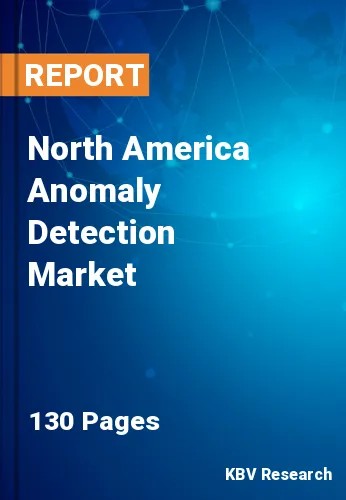The North America Anomaly Detection Market would witness market growth of 14.4% CAGR during the forecast period (2023-2030).
In all businesses, anomaly detection is crucial. Finding possibly flawed data leads to a cleaner and more trustworthy core dataset, whether it is in the financial, manufacturing, or sales sectors. Working with bad or erroneous data is less risky when anomalous data is eliminated since it increases the general integrity and worth of the data that is used regularly. Anomaly detection, for instance, can enhance quality control in the manufacturing sector by recognizing production samples that don't meet the criteria. It can also assist in determining whether a particular machine needs maintenance.
Modern approaches to identifying and monitoring cyberattacks are frequently more effective than traditional methods because of the complexity and increasing frequency of threats. A company can recognize and address unforeseen dangers with the help of anomaly detection, which offers a proactive protection strategy. Organizations may now evaluate enormous datasets in real-time owing to the machine learning (ML) field's databases and exponentially growing technological advances.
Due to the availability of scalable and potent ML approaches, the use of anomaly detection tools in cybersecurity has expanded. By incorporating these solutions into Security Operations Centres (SOCs) and incident response processes, the overall state of security can be strengthened. Because it provides real-time warnings and useful information, security analysts can effectively prioritize and respond to potential dangers. Additionally, insider attacks pose a serious threat to the security of organizations. Anomaly detection can be used to discover illicit access to critical information, weird file transfers, and anomalous network traffic from employees or authorized users.
Cybersecurity technology is urgently needed by the Canadian federal government. The nation's digital spy agency, the Communications Security Establishment (CSE), reportedly dealt with more than 2,000 attacks against the federal government and its partners in vital infrastructure in 2020, according to the International Trade Administration (ITA). In response to these continuing challenges, Canada has published its National Cyber Security Action Plan (2019–2024) and National Cyber Security Strategy. Several Canadian industries have challenges due to physical or digital security threats. Given the increasingly diverse commercial operations associated with a cyber-centric environment, operators and owners of Canada's critical infrastructure are becoming more aware of their vulnerabilities against all physical and cyber-attacks. Consequently, this region offers the market a wealth of expansion opportunities.
The US market dominated the North America Anomaly Detection Market by Country in 2022 and would continue to be a dominant market till 2030; thereby, achieving a market value of $2,979.8 million by 2030. The Canada market is experiencing a CAGR of 16.9% during (2023 - 2030). Additionally, The Mexico market would exhibit a CAGR of 15.9% during (2023 - 2030).
Based on Deployment, the market is segmented into On-premise, and Cloud. Based on Technology, the market is segmented into Big Data Analytics, Business Intelligence & Data Mining, and Machine Learning & Artificial Intelligence. Based on Component, the market is segmented into Solution (Network Behavior, and User Behavior), and Services. Based on End-Use, the market is segmented into BFSI, Government & Defense, IT & Telecom, Healthcare, Manufacturing, Retail, and Others. Based on countries, the market is segmented into U.S., Mexico, Canada, and Rest of North America.
Free Valuable Insights: The Worldwide Anomaly Detection Market is Projected to reach USD 13.4 Billion by 2030, at a CAGR of 15.9%
The market research report covers the analysis of key stake holders of the market. Key companies profiled in the report include Amazon Web Services, Inc., Broadcom, Inc., Cisco Systems, Inc., Dell Technologies, Inc., Dynatrace, Inc., Happiest Minds Technologies Limited, Hewlett Packard Enterprise Company, IBM Corporation, Microsoft Corporation and SAS Institute, Inc.
By Deployment
By Technology
By Component
By End-Use
By Country
Our team of dedicated experts can provide you with attractive expansion opportunities for your business.

